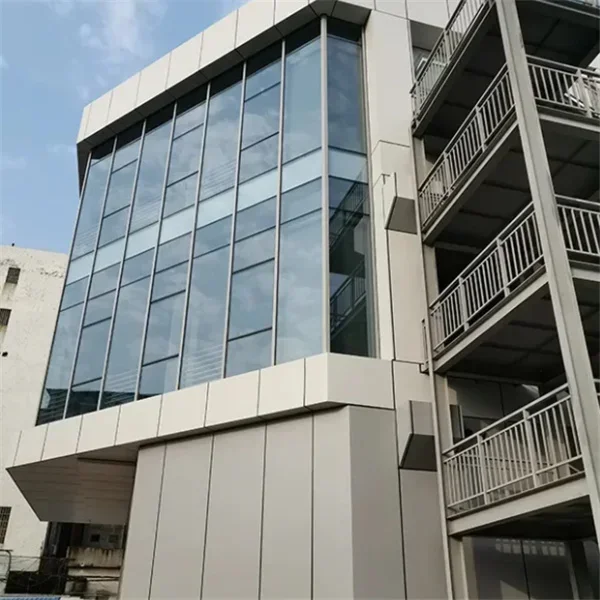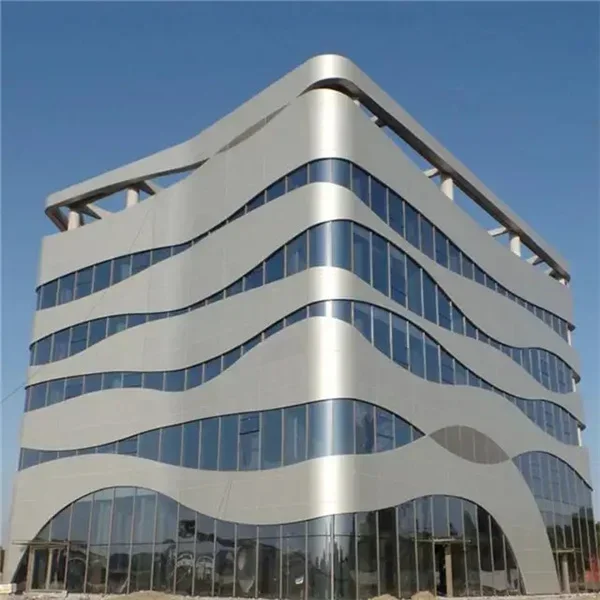Aluminum veneer curtain walls offer durability, aesthetics, and sustainability to modern architectural designs. These versatile cladding solutions provide weather protection while enhancing the visual appeal of buildings. The lightweight nature of aluminum makes it a practical choice for construction projects, reducing structural load and installation complexity. With customizable finishes and colors, aluminum veneer curtain walls cater to diverse design preferences, seamlessly blending functionality with style. Architects and developers value these systems for their cost-effectiveness and long-term performance benefits in commercial and residential applications.
Benefits of Aluminum Veneer in Construction
Durability
Aluminum veneer is renowned for its exceptional durability, making it a prime choice for constructing long-lasting buildings. The material's resistance to corrosion and weathering ensures structures remain sturdy over time. Moreover, aluminum veneer requires minimal maintenance, adding to its longevity.
Aluminum veneer stands the test of time due to its robust nature, providing structures with unparalleled strength and stability. This durability factor significantly contributes to the overall lifespan of buildings, reducing the need for frequent repairs or replacements.
Lightweight Nature
The aluminum veneer's lightweight properties make it an ideal construction material, facilitating easy installation processes. Its lightness not only simplifies handling during installation but also reduces structural load-bearing requirements. Contractors find working with aluminum veneer convenient and efficient due to its manageable weight.
The lightweight characteristic of aluminum veneer enhances construction efficiency by enabling swift installations without compromising on structural integrity. This feature streamlines the building process, saving time and labor costs while ensuring high-quality results.
Customization Options
With aluminum, veneer architects and designers have a wide array of customization options at their disposal, allowing them to create unique and visually appealing architectural designs. The material can be easily molded into various shapes, sizes, and finishes to suit specific project requirements.
Architects leverage the customization flexibility offered by aluminum veneer to bring their creative visions to life, resulting in distinctive and aesthetically pleasing building facades. From intricate patterns to bold colors, the versatility of aluminum veneer enables endless design possibilities that cater to diverse architectural styles.
Exploring Glazing Options for Enhanced Aesthetics
Architectural Glass
Architectural glass offers a sleek and modern look that complements aluminum veneer curtain walls perfectly. Its transparency allows natural light to flood the interior, creating a bright and welcoming atmosphere. With various finishes available, such as frosted or tinted glass, it provides both privacy and style.
When paired with architectural glass, aluminum veneer curtain walls achieve a seamless and elegant appearance. The combination of these elements enhances the building's aesthetics by adding a touch of sophistication while maintaining functionality. The reflective properties of architectural glass can contribute to energy efficiency by reducing the need for artificial lighting.
Performance
Considering the performance aspect of glazing options is crucial when aiming to enhance the overall aesthetics of a structure. High-performance glazing solutions not only improve energy efficiency but also impact the visual appeal of the building. Low-emissivity coatings help regulate indoor temperatures, reducing heating and cooling costs while maintaining comfort.
Selecting glazing with superior thermal performance ensures that aluminum veneer curtain walls contribute positively to the building's overall energy efficiency. By minimizing heat transfer through windows, these glazing options help create a comfortable indoor environment year-round. This not only benefits occupants but also reflects positively on the building's sustainability efforts.
Impact on Aesthetics
The choice of glazing has a significant impact on the aesthetics of a building featuring aluminum veneer curtain walls. Opting for high-quality materials such as architectural glass elevates the visual appeal by introducing reflective surfaces and enhancing natural light penetration. This results in a more inviting and dynamic facade that captures attention.
-
Pros:
-
Enhances natural light penetration
-
Adds sophistication and elegance to the building

-
Thermal Properties of Aluminum Veneer Walls
Thermal Insulation
Aluminum veneer walls enhance thermal insulation by acting as a barrier against external temperature fluctuations. They help maintain stable indoor temperatures, reducing the need for excessive heating or cooling systems.
Aluminum veneer's ability to resist heat transfer plays a crucial role in minimizing energy consumption within buildings. By effectively insulating structures, these walls contribute to significant energy savings over time.
Energy Efficiency
The energy-efficient properties of aluminum veneer curtain walls make them a popular choice for sustainable construction projects. Their thermal performance helps in regulating indoor temperatures and reducing reliance on HVAC systems.
These walls are designed to minimize heat loss during cold weather and prevent excessive heat gain in warmer months. This results in improved overall energy efficiency and reduced environmental impact.
Heat Loss Reduction
Aluminum veneer walls play a vital role in reducing heat loss through building envelopes, ensuring that interior spaces remain comfortable throughout the year. By creating a thermal barrier, they help prevent heat from escaping during winter, leading to lower heating costs.
Moreover, these walls also contribute to maintaining cooler indoor temperatures in summer by reflecting sunlight and reducing solar heat gain. This feature not only enhances comfort but also reduces the demand for air conditioning, promoting sustainability.
Impact-Resistant Features for Building Safety
External Forces
Aluminum veneer curtain walls offer exceptional resistance to external forces, such as strong winds and impacts from debris. This durability ensures the safety of buildings in areas prone to extreme weather conditions.
The ability of aluminum veneer to withstand high winds and flying objects is crucial for maintaining the structural integrity of buildings during storms and hurricanes. The impact-resistant nature of these walls minimizes the risk of damage and enhances overall safety.
Structural Integrity
Aluminum veneer plays a vital role in enhancing the structural integrity of buildings, especially in residential applications. In the event of accidents or natural disasters, such as earthquakes, the sturdy construction of these walls provides added protection to occupants.
These curtain walls act as a protective shield, safeguarding the interior spaces from external threats. By reinforcing the building envelope, aluminum veneer contributes significantly to ensuring the safety and security of residents.
Blast Resistance for Enhanced Security
Protection Benefits
Aluminum veneer curtain walls are crucial for providing blast resistance in high-risk environments. They enhance security by mitigating potential threats and minimizing the impact of explosions. The ability of aluminum veneer to absorb and disperse energy makes it a vital component in safeguarding buildings against blasts.
Aluminum veneer's durability ensures that it can withstand significant force, making it an effective barrier against external hazards. By dispersing the force generated by explosions, aluminum veneer helps in reducing damage to the building's structure. This capability is essential for ensuring the safety and well-being of occupants within the building.
Safety Measures
In high-risk areas where security is a top priority, the installation of aluminum veneer curtain walls is a strategic safety measure. These walls act as a protective shield, absorbing and redirecting energy away from the building during a blast event. By effectively containing the impact, aluminum veneer plays a crucial role in safeguarding occupants.
Aluminum veneer curtain walls are engineered to provide optimal protection without compromising on aesthetics. Their sleek design and customizable finishes make them an ideal choice for buildings requiring both security and visual appeal. The versatility of aluminum veneer allows architects to integrate safety features seamlessly into the overall design of the structure.

Security Features of Aluminum Curtain Walls
Advanced Technology
Aluminum curtain walls are equipped with cutting-edge security technology, ensuring robust protection against potential threats. The integration of advanced sensors and alarms enhances the overall security system.
The utilization of high-quality materials in aluminum curtain walls significantly improves the structural integrity, making it difficult for unauthorized access or forced entry. These features provide a strong defense mechanism against intruders.
Enhanced Safety Measures
Incorporating impact-resistant glass into aluminum curtain walls strengthens the building's defenses against various risks such as break-ins or natural disasters. This feature ensures the safety of occupants within the premises.
Aluminum curtain walls are designed to withstand extreme weather conditions, offering a secure environment for occupants. The durability and strength of these walls contribute to long-term protection and peace of mind for building inhabitants.
Secure Environment Creation
The installation of surveillance cameras and access control systems on aluminum curtain walls enhances security monitoring capabilities. This proactive approach helps in preventing security breaches and ensures a safe environment for everyone.
Frame Depth and Infill Options
Frame Depth
Aluminum veneer curtain walls rely on optimal frame depth to ensure structural stability and durability. The frame depth plays a crucial role in supporting the entire curtain wall system. It determines the ability to withstand wind loads and other external forces, making it a fundamental aspect of the system's performance.
Adequate frame depth enhances the overall strength of the curtain wall, providing necessary support for the infill materials. By choosing an appropriate frame depth, architects and engineers can customize the design based on specific project requirements. For instance, buildings in high-wind areas may require deeper frame depths to ensure resilience against harsh weather conditions.
The selection of frame depth is a critical decision that impacts both the functionality and aesthetics of aluminum curtain walls. It influences not only the structural integrity but also the visual appeal of the building façade. Balancing these aspects is essential to create a harmonious design that meets both technical and aesthetic standards.
Infill Options
When it comes to infill options for aluminum veneer curtain walls, there is a wide range of materials available, each offering unique properties and benefits. Common infill materials include glass, metal panels, stone veneer, and composite materials. The choice of infill material depends on factors such as thermal performance, acoustic insulation, and design preferences.
Glass infills are popular for their transparency and ability to maximize natural light within a building. On the other hand, metal panels provide durability and a modern aesthetic appeal. Stone veneer infills offer a timeless look with natural textures, adding a touch of elegance to architectural designs.
By selecting the right infill material, architects can enhance not only the visual appearance but also the functional performance of aluminum curtain walls. Each material brings its unique characteristics to the façade, contributing to the overall sustainability and efficiency of the building envelope.
Impact on Performance and Aesthetics
The combination of frame depth and infill options has a significant impact on both the performance and aesthetics of aluminum veneer curtain walls. The synergy between these elements determines how well the system functions structurally while achieving desired visual effects.
Optimizing frame depth along with selecting suitable infill materials is essential for ensuring that aluminum curtain walls meet building codes, energy efficiency standards, and design objectives. Architects must carefully consider these factors during the design phase to achieve a balance between structural integrity, thermal performance, and aesthetic appeal.

Final Remarks
The benefits of utilizing aluminum veneer curtain walls in construction are evident, from enhanced aesthetics to improved thermal properties and increased safety measures. The exploration of glazing options, impact-resistant features, blast resistance, and security components further solidifies the position of aluminum veneer as a versatile and reliable choice for modern architectural projects. Frame depth variations and infill options provide additional flexibility, catering to diverse design requirements.
For those considering innovative solutions in construction, aluminum veneer curtain walls present a compelling option worth exploring. With their multitude of advantages ranging from aesthetic appeal to functional properties, these walls offer a blend of style and substance that can elevate any building project. Embracing the use of aluminum veneer curtain walls can lead to not only visually striking structures but also spaces that prioritize safety, energy efficiency, and durability.

